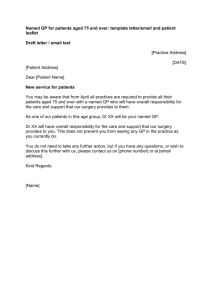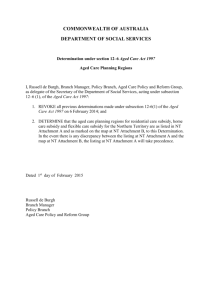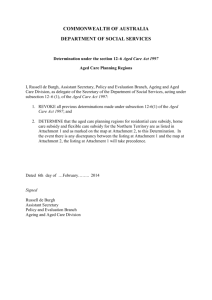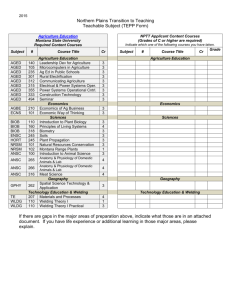Attraction, Recruitment & Retention Strategy & Action Plan
advertisement
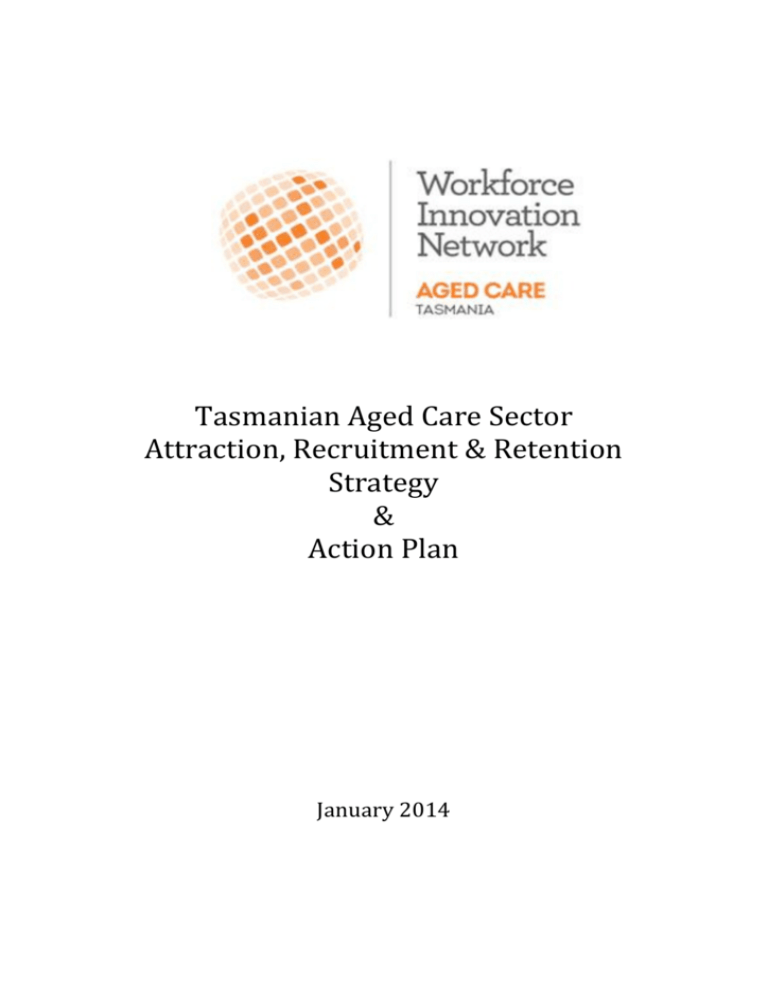
Tasmanian Aged Care Sector Attraction, Recruitment & Retention Strategy & Action Plan January 2014 Table of Contents Foreword ............................................................................................................................... 4 Overview ................................................................................................................................ 5 Background and Consultation........................................................................................ 6 Attraction .............................................................................................................................. 6 Recruitment .......................................................................................................................... 7 Retention ............................................................................................................................... 8 Career Pathways ................................................................................................................. 9 Detailed Action Plan ....................................................................................................... 11 Definitions Aged Care Services- aged care services, community care services and retirement villages. Employee Value Proposition- Effective employer branding that seeks to: • define what the organisation would most like to be associated with as an employer • highlight the attributes that differentiate the organisation from other employers • clarify what employees and the employer ‘get’ from the employment deal Place Based Thinking- “...the ability of places to grow drawing on their own resources, notably their human capital and innovative capacities.”1 List of Abbreviations ACST Aged Care and Community Services Tasmania EVP Employee Value Proposition JSA RTO Strategy and Action Plan TAWIN VET Job Services Australia Registered Training Organisation Attraction, Recruitment and Retention Strategy and Action Plan Tasmanian Aged Care Workforce Innovation Network Vocational Education and Training 1 2013. Future-Proofing Local Government: National Workforce Strategy 2013-2020. P 41 V17 Page 2 of 20 Disclaimer The information contained in this document has been sourced from various consultations, publications and websites. The Consultants accept no responsibility for the accuracy or completeness of the information gained from these sources and recommends that readers exercise their own skill and care with respect to its use. V17 Page 3 of 20 Foreword Darren Mathewson Chair Tasmania Aged Care Workforce Innovation Network, and Chief Executive Officer Aged and Community Services Tasmania (ACST) V17 Page 4 of 20 Overview The TAWIN has developed an Attraction, Recruitment and Retention Strategy and Action Plan (Strategy and Action Plan) to assist the aged care services sector in Tasmania adapt to the reform agenda and bridge the gap between the current workforce and the target (future) workforce. The process to date has drawn on industry expertise from across the state. The strategies consolidate and build on the achievements of the Aged Care Services Industry Skills Plan, assisting those in the sector to deliver quality services in a sustainable manner. The Strategy and Action Plan outlines a range of strategies that form a framework with the following key headings: Attraction, Recruitment, Retention and Career Pathways. The identified actions will be implemented over a threeyear period, January 2014 to December 2017, with periodic reviews. The Strategy and Action Plan supports: • • • • • • • Promoting the positive image and role of the aged care services sector in Tasmania Equipping the sector to meet increasing workforce challenges in Tasmania Review current programs to attract, recruit and retain appropriate staff, i.e. mature age, single parents, etc. Increase effectiveness and efficiencies in recruitment Increasing the job satisfaction of those employees already in the sector Proactively influencing government policy and funding Develop and promote career pathways which support the exploration of job roles in line with a reformed aged care sector As part of a national program TAWIN is a conduit for nationally focused approaches. It also operates as part of a national network with access to planning resources and materials in other states and territories. TAWIN has drawn on the expertise and best practice already developed and relevant to this Strategy and Action Plan. The Strategy and Action Plan is a living document, requiring ongoing evaluation in a changing environment to realise intended outcomes. Responsibility for achieving the goals of this Strategy and Action Plan however will rely on action and commitment from aged care service providers; engagement of their staff and collaboration with supporting stakeholders. Implementation will be accompanied by progress towards the action plan and reported to the Industry Reference Group (who will have implementation responsibility past the life of the TAWIN). V17 Page 5 of 20 Background and Consultation The Attraction, Recruitment, Retention and Career Pathways Strategies have been developed through an Aged Care Workforce Innovation Regional Project on behalf of the Tasmanian aged care services sector. The services sector in Tasmania, as in other states and territories of Australia, is characterised by: • • • • • • • • • • An ageing workforce A growing workforce Substantial levels of part-time and casual employees Movement of labour between service organisations Small single site facilities through to larger multi site organisations Organisations spread across the state Reductions in government funding Community’s perceptions of the aged care industry A requirement for staffing seven day a week, 52 weeks a year and 24 hours a day The context of aged care and health reforms TAWIN has worked in close consultation with individual service providers of varying sizes throughout the state and the sector as a whole to develop these strategies. Significant qualitative and quantitative information has been gained via forums, surveys and consultation. The Strategy and Action Plan has also benefited from the input of other key stakeholders working with the sector, such as JSAs, RTOs and Skills Tasmania. TAWIN acknowledges the many organisations and individuals for the valuable input and time they have given to this project. Their important contribution will ensure the Strategy and Action Plan is relevant to the continuing success of the sector, both now and into the future. As well as this Strategy and Action Plan, aged care services in Tasmania have an Industry Skills Plan and an IT and E Strategy. They are designed to work together in achieving their collective aims and objectives. Attraction Tasmania's ageing population will have a greater reliance on aged care services in the future, and consequently the required workforce will grow. This will put further strain on workforce numbers unless the sector can attract the appropriate staff. However, there are several challenges associated with generating positive interest in the employment opportunities of the aged care services sector. The current image of aged care services does not adequately V17 Page 6 of 20 reflect the variety of roles across in the sector, and image related issues on the whole have made it traditionally difficult to attract workers. As identified in the 2010 Aged Care Services Industry Skills Plan, some informal planning is undertaken by individual organisations, but there is a need to develop a ‘whole of sector’ plan aimed at consistently promoting the sector’s strengths. Attraction strategies include: • • • • • • • Marketing the sector via traditional and social media as a: o Career of Choice- with structured career paths for a range of participants o Employee Value Proposition- matching employee and organisational values necessary for both to be successful o Place Based Thinking- the ability of places to grow drawing on their own resources, notably their human capital Promotion of career pathways showing the ability of staff to progress from entry level positions via traditional and non traditional methods Targeting particular demographic groups, e.g. mature aged and school leavers Mapping and promoting multiple entry points that allow workers of varying skill levels to begin or restart careers within the aged care sector Development of a communications strategy for the effective engagement of stakeholders Enhancing pre-employment experiences of potential staff with the sector through programs and placements Establishing a portal and communication network, which supports the suite of attraction strategies, i.e. provide practical advice about the Tasmanian sector Recruitment The process of finding, screening, and selecting employees can be a difficult exercise, especially with Tasmania having some of the lowest workforce participation rates in Australia. The costs of recruitment to the aged care sector can be prohibitive with a number of providers not having a dedicated human resource role. To address this and ensure greater efficiencies and effectiveness in recruitment a number of strategies have been established. For example ACST began the Graduate Nurse Program, which has introduced over 90 nurses to the sector in just three years. Hence, the Graduate Nurse Program has encouraged ‘recruiting outside the square’ to help increase workforce participation. Traditionally the sector has relied on a merit based selection process to appoint applicants. Broadening the recruitment net may necessitate the use of alternative selection processes that will maintain appropriate levels of care for example appointing an employee who has the capacity to ‘grow’ into the job with training and support. Recruitment strategies include: V17 Page 7 of 20 • • • • • • Collaboration across the aged care sector to create economies of scale and minimise barriers Creating a better understanding of what the aged care sector needs with VET, Higher Education and Job Services Australia providers Build on the success of proven models to streamline and create entry programs for the aged care sector Target potential employees from: o Other sectors with similar skill sets, i.e. childcare, disability o Re-engagement of former employees o Allied health professionals Implement school based traineeships by working with schools to provide positive experiences in the Aged Care Services Sector Establish a portal and communication network for the sector to be used by external parties seeking relevant information about joining the sector, i.e. an employment register Retention As well as attracting additional workers, the aged care sector needs to retain its current workforce. An effort by the sector to maintain a working environment, which supports current staff in remaining, is critical. During consultation stakeholders at an Industry Forum reported that remuneration is a significant issue. In Tasmania the Aged Care Services sector averaged 17% staff turnover in 2010-11, with Registered Nurses having the highest turnover of any occupational group with just under 26%.2 Hence, to retain staff, policies could be developed to combat the remuneration problems and increase job satisfaction. Where retention is not possible, a range of workforce practices and systems that supports the transfer of skills and knowledge should be implemented. Retention strategies include: • • • • • • • Collecting job satisfaction data Maintenance of forums and reference groups that identify training and development solutions for the sector Increasing understanding of ‘fit for job role’ Establishing programs and strategies that target specific demographic groups such as: o 18-25 year age group o Mature workers o Single parents Encourage succession planning to achieve transfer of skills and knowledge Research and promote innovative approaches to remuneration Support the creation of contemporary workplaces which may require the redesign of work flows and job roles 4 Jan 2002. Aged & Community Services Tasmania Survey – Preliminary Report. IMC Link, p 6. V17 Page 8 of 20 • Expand networks for communication and learning - as avenues for sharing technical expertise, training resources, information and ideas The Sector also recognises the importance of ongoing training and professional development that is industry driven to meet current and future needs of both staff and employers. Career Pathways Career pathways are integral to the attraction, recruitment and retention strategies and offer a clear alignment with training and professional development that meet employer requirements. The aged care sector needs to work closely with VET and Higher Education providers to ensure they support this and break down any barriers that may limit career pathways. Key components of a career pathway approach include the identification of an individual’s capability, matched to required roles and ongoing skills development. This must be appropriate for the individual, giving credit for prior learning, building on existing skills and adopting strategies that accelerate the educational and career advancement of the participant. Organisations who have internal processes that expose employees to different roles, ensure career pathways are available. However the sector must build on this and develop programs that will identify and support career pathways between community and residential services. Multiple entry and exit points will allow workers of varying skill levels to begin or advance within the aged care sector. Mobility of roles across the sector could also assist with the enhancement of career pathways. Finally, programs and systems incorporating individualised training and career mentoring, as well as wrap-around support services (particularly at points of transition), could support the development of individual career plans. Career pathway strategies include: • • • • • V17 Engaging key partners at the local and state levels, agreeing to a shared vision, and gaining support from stakeholders. Roles and responsibilities are clearly defined and formalised and required skills sets are clear Defining career pathways so there are clear sequences of education courses, qualifications and experience that meet current and future skill needs Pursuing state and local policy and administrative reforms in order to promote career pathway system development and to support implementation Working with RTOs to map and deliver skills sets that will enable staff to work across the aged care and disability sectors Creating clear and graduated pathways between home and community services and residential services Page 9 of 20 • • • V17 Assessing system-wide change and measuring performance outcomes to ensure continuous improvement Developing promotional material for attraction, recruitment and retention purposes Identifying individual capabilities and matching them to current and future roles Page 10 of 20 Detailed Action Plan Strategy 1 Attraction 1.1 Aim: Outcome: Ensure the aged care sector has the required people employed Action The Tasmanian Aged Care Sector is seen as a career of choice Associated Actions Career Pathways Promote the aged care sector as a career of choice. Promote a favourable and realistic view of the sector throughout the state and undertake crosssector marketing. Priority High TAWIN ACST Service Providers Medium Service Providers TAWIN Recruitment 1.2 V17 As part of this process we will: • Research effective marketing campaigns developed by various members of the sector, i.e. national, state, and individual organisations • Develop a statewide corporate image (leveraging off the work already done) with core messages around: o Career of Choice o Employee Value Proposition o Place Based Thinking • Highlight the different models of care, eg CDC and NDIS • Encourage sector members to integrate the core messages in their promotion and attraction campaigns • Employ the appropriate mix of new and traditional media Develop strategic partnerships that will enhance open communication and actively support the positive promotion of the sector, i.e. schools, VET, university and allied health professional bodies. Stakeholders Retention Recruitment Page 11 of 20 Timeframe 1.3 Actively target particular demographic groups underrepresented in the current aged care workforce: • • Career Pathways Low Mature aged School leavers 1.4 Facilitate the development of individual and organisational ‘Ambassadors’ to promote the aged care sector via personal testimonials. Career Pathways Medium 1.5 Develop a Communications Strategy for the effective engagement of stakeholders. Facilitate enrolment into entry-level training and development programs with a view to attracting trainees to the sector, with a focus on entry-level qualifications. Recruitment High Retention Medium 1.6 V17 Page 12 of 20 Schools VET Sector University Allied Health Professional Bodies JSAs Schools RTOs Service Providers ACST Service Providers Employees ACST All Service Providers RTOs Strategy 2 Recruitment 2.1 2.2 V17 Aim: Outcome: Increase the capability of the Tasmanian Aged Care Services Sector to identify and attract potential employees. Action The aged care sector workforce in Tasmania is appointed from a highly competitive process and meets the needs of the ageing Tasmanian community Focus on reducing the barriers into the sector and create multiple entry points for potential staff: • Research existing programs to identify what works and share with each other. Eg New Directions and Graduate Nurse Program • Work collaboratively across stakeholders to create supportive partnerships and ensure training remains responsive to industry demands • Develop meaningful opportunities for prospective employees to engage with the sector, i.e. volunteering, traineeships, work experience • Explore opportunities for shared employees across organisations as we utilise the Employment Register • Strategically increase support mechanisms for employees entering the Tasmanian Aged Care Services Sector such as: o Sharing best practice in induction processes o Mentor/Buddy guidelines o Investigating role fit Through the continuation of reference groups/networks, work in partnership with training providers to develop and implement preemployment and entry level training programs that support/promote: • The participation of people who will realistically be employed by the sector Associated Actions Recruitment Priority High Stakeholders RTOs Service Providers Industry Reference Group Attraction Career Pathways Page 13 of 20 High RTOs JSAs Service Providers Industry Timeframe 2.3 A realistic understanding/perspective of what it means to work in the sector • Participants who are equipped with the required skills and knowledge to be effective and efficient entry level workers • Consistent delivery and quality of the training being provided Continue the Graduate Nurse Program. 2.4 2.5 • 2.6 2.7 2.8 V17 Retention Reference Group Career Pathways High Implement the Enrolled Nurse Transition to Practice Program. Career Pathways High Broaden recruitment practices to include alternative selection processes to the merit-based model to enable appointing an employee who has the capacity to ‘grow’ into the job with training and support. Retention Low TAWIN/ACST Service Providers Attraction Low Service Providers Attraction Low Schools Attraction High Job seekers JSAs RTOs Aged Care Service As part of this process we will: • Research models • Disseminate information on best practice through the IT ‘portal’ Establish a program of targeting potential employees including: • Other sectors with similar skill sets, i.e. childcare, disability • Re-engage former employees • Allied health professionals Implement School Based Traineeships by working with schools and organisations such as the Beacon Foundation to provide positive experiences in the Aged Care Services Sector. Establish an employment register through an IT network system/portal which can be used by all stakeholders: • Job seekers • JSAs • RTOs Career Pathways Page 14 of 20 ACST University Service Providers ACST VET • Aged Care Service Providers • Schools Include positive personal testimonials. 2.9 Investigate the viability of a model to facilitate the mobility of staff such as workflow redesign and a Statewide Aged Care and Community Care Enterprise Bargaining Agreement. 2.10 Continue the New Directions Program Strategy 3 Retention 3.1 3.2 V17 Providers Schools Retention Low Attraction High Service Providers Union Bodies Service Providers ACST Aim: Outcome: Increase the capability of the Tasmanian Aged Care Services Sector to support current staff in remaining in the sector. Action Organisational processes ensure the current and future workforce has high job satisfaction levels Conduct a: • Comprehensive ‘Skills Audit’ in relation to the current and future skills and knowledge requirements of our workforce • A job satisfaction survey Based on the information received through our ‘Skills Audit’, job satisfaction survey and exit surveys: • Inform/educate relevant stakeholders of the outcomes of our ‘Skills Audit’ • Encourage/support the sector to: o Provide opportunities for promotion from within, thereby enabling employees to reach their potential within their current organisation Associated Actions Career Pathways Attraction Priority Stakeholders High Service Providers ACST High Service Providers Recruitment RTOs Career Pathways Page 15 of 20 JSAs ACST Timeframe Provide job-fit for people and valuing job satisfaction Create contemporary workplaces and the redesign of workflows and job roles o Utilise personal development plans and promote further studies o Develop a skill matrix and a register aimed at defining opportunities for staff to fully utilise their skills o Utilise mentoring, interim placement, job swaps, secondments and taking on the responsibilities of more senior staff on a temporary basis as opportunities for staff to perform higher duties o Explore the feasibility of a ‘whole of sector’ job satisfaction survey tool and an exit survey tool on an online portal to ensure the collection of consistent data TAWIN, (and then the Industry Reference Group), will research and maintain an awareness of any opportunities for the sector to access funding for training and development. TAWIN will implement strategies to ensure that the sector is kept up to date with this information, such as: • Exploring the feasibility and ongoing viability of accessing funding to establish an ‘Industry Skills Centre’ in the North and North West of the State, in line with the one in the South Continue networks – RTO Roundtable and Industry Reference Group, and continue to develop other networks as required. o o 3.3 3.4 Career Pathways Low ACST RTOs Service Providers Career Pathways High Career Pathways Medium Service Providers TAWIN RTOs Industry Reference Group Service Providers Develop and implement protocols and processes that support/promote the delivery of quality training (accredited and non accredited) and development 3.5 Research and promote innovative approaches to remuneration. Explore creative methods of remunerating staff, for example: V17 Page 16 of 20 3.6 3.7 3.8 3.9 V17 • Acknowledging long service in the sector • Gala nights • ‘Well done’ category in staff newsletters • Movie vouchers Retain the workforce where possible, to ensure business continuity and excellence in service delivery. Focus on: • 18-25 year age group • Mature workers • Single parents We will do this through: o Researching other sectors’ retention methods and learning from ourselves o Sharing the information with Aged Care Service Providers o Mentoring Implement programs to develop succession and workforce planning. We will do this by: o Undertaking research to identify core components of succession and workforce planning o Identifying and promoting tools and models Continue reference groups and networks focused on communication and learning for the sharing of: • Technical expertise • Training resources • Ideas Build inclusive culture across the sector and at the organisational level by: • Attracting the ‘right’ staff to the ‘right’ jobs (marketing of industry and specific organisations) • Empowering staff – involving them, providing opportunities for input to service design and harnessing current knowledge and Career Pathways Medium TAWIN/ACST Service Providers Career Pathways High ACST Service Providers Career Pathways High All Attraction High Service Providers Career Pathways Page 17 of 20 JSAs • • • • • • skill Professional development Building culture and values into all you do Developing strong leaders Changing from a ‘just caring’ to service culture Creating and promoting flexible conditions, work/life balance and job satisfaction. Maximising flexibility and work preferences for staff (e.g. across agencies HACC/residential) Value adding/building onto job role (clearly defined) Strategy 4 Career Pathways 4.1 Aim: Outcome: Increase the capability of the Tasmanian Aged Care Services Sector to ensure career pathways are available Action Clearly articulated career pathways exist at an organisation and ‘whole of sector’ level and staff are encouraged and supported to pursue them Associated Actions Attraction Review and update the Industry Skills Plan. As part of this process we will: • Facilitate, implement and promote programs to educate the sector on workforce planning and the associated benefits • Continue to collect, analyse and disseminate information that will support evidence based workforce planning • Given the changing environment and demographics of aged care services in Tasmania, conduct workshops/forums monitor progress V17 RTOs Priority High Stakeholders TAWIN Retention ACST Career Pathways Service Providers Page 18 of 20 Timeframe towards developing ‘the workforce of the future’ Undertake a mapping exercise to identify current roles and analyse future need. Knowledge of particular job roles will assist with knowing which skills are needed for each specific role • Work with RTOs to map and deliver skills sets that will enable staff to work across the aged care and disability sectors Develop and invest in career pathways within the sector. Identify opportunities to source funding to assist this. Raising and/or leveraging necessary resources to develop and operate the career pathway system and its education and training programs. Develop both internal and external programs that enable career pathways between home and community services and residential services. Develop diverse and flexible entry pathways to a career in Aged Care. • 4.2 4.3 4.4 4.5 4.6 Promote career pathways that show the ability of staff to progress from entry level positions via traditional and non-traditional methods. Support employees’ career development through the provision of mentoring, professional development and training. Undertake effective promotion of the sector via various media platforms to highlight positive opportunities (e.g. growth sector, multiple career pathways). Medium Service Providers ACST Retention High Attraction Recruitment Retention High Retention High Attraction High Service Providers Service Providers ACST TAWIN Service Providers Service Providers TAWIN ACST Attraction Low Develop resources for ‘whole of sector’ and at an organisation level in printed and electronic formats. 4.7 V17 Raising industry profile through strong marketing program; such as banks, defence force, local government, agriculture. Build partnerships with: • RTOs • Recruiters • Schools (all tiers) Page 19 of 20 RTOs JSAs Schools Service 4.8 Ensure potential career pathways are communicated to, and understood by, students considering a career in the aged care sector. Develop a program for Allied Health Professionals’ training and education in Tasmania. Attraction High Providers ACST Service Providers Recruitment 4.9 V17 Research other programs to investigate the feasibility of providing opportunities for trained dental aged care nurses, nurse practitioners and allied health professionals to work in the aged care sector. Service Providers work collaboratively and discuss their organisational career pathway processes and undertake gap analysis to build organisational capacity. Retention Page 20 of 20 Medium Service Providers
